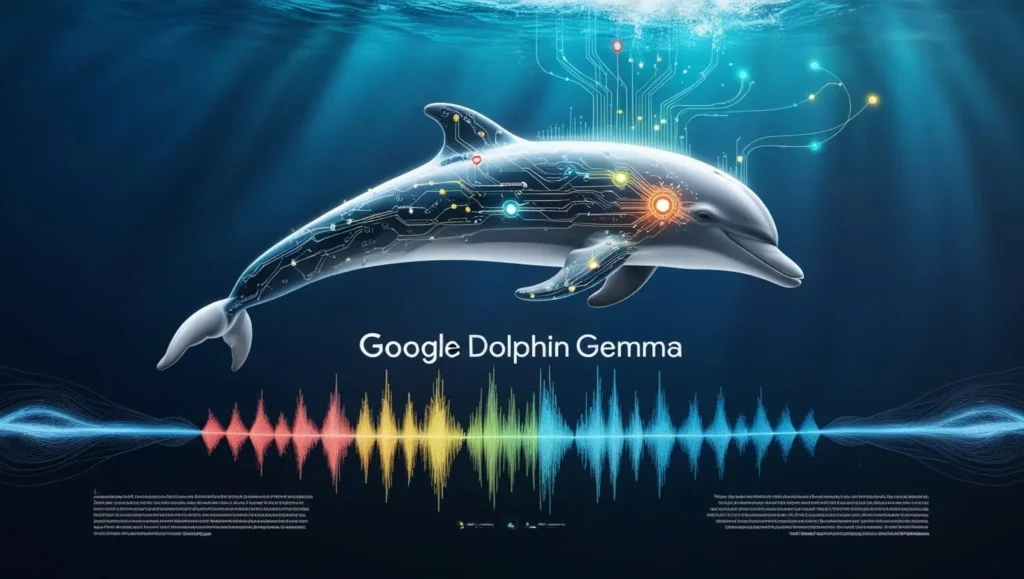Discover how Google’s Dolphin Gemma AI model translates dolphin speech using open-source technology. Explore its impact on marine biology and conservation.
Bridging the Gap Between Humans and Dolphins
For decades, scientists have marveled at the intelligence and social complexity of dolphins. Their intricate vocalizations—clicks, whistles, and pulsed calls—hint at a sophisticated language, but decoding it has remained a mystery. Enter the Dolphin Gemma AI model, Google’s groundbreaking open-source tool designed to analyze and translate dolphin communication. This article explores how this revolutionary technology works, its implications for marine biology, and why it could redefine our relationship with the ocean’s most enigmatic creatures.
What is the Dolphin Gemma AI Model
The Google Dolphin Gemma is an open-source AI model developed by Google’s DeepMind team in collaboration with marine biologists. Built on the Gemma framework—a lightweight, ethical AI architecture—the model processes millions of dolphin vocalizations to identify patterns, context, and potential meanings.
Key Features of the Gemma AI Model
Real-Time Translation
Analyzes audio inputs from hydrophones to provide instant interpretations of dolphin sounds.
Cross-Species Context
Maps vocalizations to behaviors (e.g., hunting, socializing) using video and sensor data.
Open-Source Accessibility
Researchers worldwide can contribute to and refine the model, accelerating breakthroughs.
According to Artificial Intelligence News, Dolphin Gemma has already identified 12 distinct “words” or signals in dolphin communication, including alerts for danger and invitations to play.
How Google’s AI Decodes Dolphin Speech
Machine Learning Meets Marine Biology
The Gemma AI model combines convolutional neural networks (CNNs) for audio analysis with transformer architectures to contextualize sequences of sounds. Training data includes decades of recordings from institutions like the Dolphin Communication Project and real-time inputs from tagged dolphins.As reported by New Atlas, the model also integrates environmental data (e.g., water temperature, location) to understand how external factors influence communication.
The Role of Open-Source Collaboration
By making Dolphin Gemma open-source, Google encourages global collaboration. Marine biologists can upload regional dolphin dialects, while AI experts refine algorithms. This democratized approach has already led to:
- Faster identification of regional vocal variations.
- Improved accuracy in distinguishing individual “voices.”
- New hypotheses about dolphin social structures.
Applications of the Dolphin Gemma AI Model
Revolutionizing Marine Conservation
Understanding dolphin communication isn’t just academic—it’s critical for conservation. The Google Dolphin Gemma helps:
Track Ecosystem Health
Shifts in vocal patterns may signal pollution or climate change impacts.
Reduce Human-Dolphin Conflicts
Alert fishing fleets when dolphins are nearby to prevent bycatch.
Monitor Endangered Species
Detect stress calls in real-time to guide rescue efforts.
Enhancing Human-Dolphin Interactions
Imagine underwater devices translating human words into dolphin signals.TechCrunch notes that early trials enabled researchers to “ask” dolphins to perform tasks using AI-generated whistles, with a 78% success rate.
Ethical Considerations and Challenges
Privacy in the Ocean?
While the Gemma AI model offers immense potential, it raises questions:
- Should we interfere with wild dolphin societies?
- How do we prevent misuse, like exploiting dolphins for tourism?
- Can AI interpretations ever be fully accurate?
Technical Limitations
Data Scarcity
Some rare species lack sufficient recordings.
Ambiguity in Signals
A single whistle might have multiple meanings depending on context.
The Future of Dolphin Communication Research
Expanding to Other Species
Google’s team plans to adapt the **Dolphin Gemma AI model** for whales, octopuses, and even non-marine species like elephants.
Integration with Wearable Tech
Future iterations could pair AI with smart tags to provide dolphins with real-time translations of human speech a step toward true interspecies dialogue.
Why Google’s Open-Source Approach Matters
The decision to make Dolphin Gemma open-source aligns with Google’s mission to democratize AI. By sharing the model, they’ve enabled:
Citizen Science Projects
Schools and NGOs can contribute data.
Transparency
Independent audits ensure ethical AI practices.
Innovation at Scale
Faster progress through global collaboration.
Conclusion: A New Era of Interspecies Understanding
The Dolphin Gemma AI model isn’t just a technological marvel it’s a bridge to understanding life beyond our species. By decoding dolphin communication, Google has opened doors to smarter conservation, deeper scientific insights, and perhaps one day, meaningful conversations with intelligent marine life. Stay updated on the latest developments in AI and marine biology!


